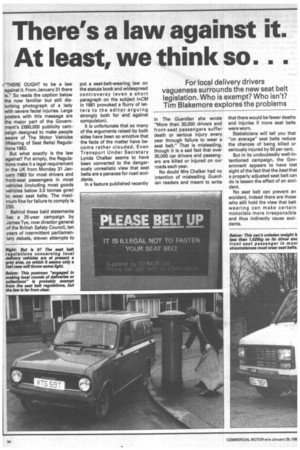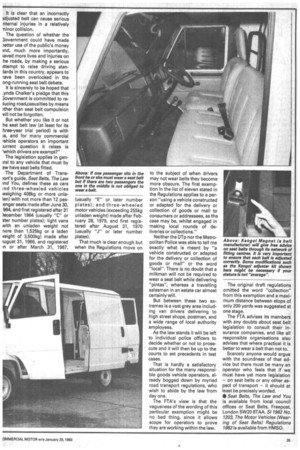There's a law against it.
Page 36

Page 37

If you've noticed an error in this article please click here to report it so we can fix it.
At least, we think so. . .
For local delivery drivers vagueness surrounds the new seat belt legislation. Who is exempt? Who isn't? Tim Blakemore explores the problems
,"THERE OUGHT to be a law against it. From January 31 there is." So reads the caption below the now familiar but still disturbing photograph of a lady with severe facial injuries. Large posters with this message are the major part of the Government's E680,000 publicity campaign designed to make people aware of The Motor Vehicles (Wearing of Seat Belts) Regulations 1982.
But what exactly is the law against? Put simply, the Regulations make it a legal requirement in the UK from Monday 31 January 1983 for most drivers and front-seat passengers in most vehicles (including most goods vehicles below 3.5 tonnes gvw) to wear seat belts. The maximum fine for failure to comply is .E50.
Behind these bald statements lies a 25-year campaign by James Tye, now director general of the British Safety Council, ten years of intermittent parliamentary debate, eleven attempts to put a seat-belt-wearing law on the statute book and widespread controversy (even a short paragraph on the subject inCM in 1981 provoked a flurry of letters to the editor arguing strongly both for and against compulsion).
It is unfortunate that so many of the arguments raised by both sides have been so emotive that the facts of the matter have become rather clouded. Even Transport Under Secretary Lynda Chalker seems to have been converted to the dangerously unrealistic view that seat belts are a panacea for road acci.dents.
In a feature published recently in The Guardian she wrote "More than 30,000 drivers and front-seat passengers suffer death or serious injury every year through failure to wear a seat belt." That is misleading, though it is a sad fact that over 30,000 car drivers and passengers are killed or injured on our roads each year.
No doubt Mrs Chalker had no intention of misleading Guardian readers and meant to write
that there would be fewer deaths and injuries if more seat belts were worn.
Statisticians will tell you that "on average" seat belts reduce the chances of being killed or seriously injured by 50 per cent.
But in its undoubtedly well-intentioned campaign, the Gov ernment appears to have lost sight of the fact that the bestthat a properly adjusted seat belt can do is lessen the effect of an accident.
No seat belt can prevent an accident, indeed there are those who still hold the view that belt wearing can make certain motorists more irresponsible and thus indirectly cause accidents. It is clear that an incorrectly adjusted belt can cause serious nternal injuries in a relatively rinor collision.
The question of whether the 3overnment could have made )etter use of the public's money md, much more importantly, ;eyed more lives and injuries on he roads, by making a serious It-tempt to raise driving stenJards in this country, appears to lave been overlooked in the ong-running seat belt debate.
It is sincerely to be hoped that _ynda Chalker's pledge that this 3overnment is committed to reiucing road,casualties by means yther than seat belt compulsion vill not be forgotten. '
But whether you like it or not he seat belt law (at least for its hree-year trial period) is with is, and for many commercial vehicle operators an important !urrent question it raises is 'which drivers are exempt?"
The legislation applies in geniral to any vehicle that must by aw have seat belts fitted.
The Department of Trans. port's guide, Seat Belts, The Law Ind You, defines these as cars Ind three-wheeled vehicles weighing 408kg or more unlalen) with not more than 12 pas
enger seats made after June 30, 964, and first registered after 31 )ecember 1964 (usually "C" or ater number plates); light vans with an unladen weight not nore than 1,525kg or a laden veight of 3,500kg) made after ■ ugust 31, 1966, and registered ■ ri or after March 31, 1967, (usually "E" or later number plates); and three-wheeled motor vehicles (exceeding 255kg unladen weight) made after February 28, 1979, and first registered after August 31, 1970 (usually "J" or later number plates).
That much is clear enough but when the Regulations move on to the subject of when drivers may not wear belts they become more obscure. The first exemption in the list of eleven stated in the Regulations applies to a person "using a vehicle constructed or adapted for the delivery or collection of goods or mail to consumers or addressees, as the case may be, whilst engaged in making local rounds of deliveries or collections."
Neither the DTp nor the Metropolitan Police was able to tell me exactly what is meant by "a vehicle constructed or adapted for the delivery or collection of goods or mail" or the word "local". There is no doubt that a milkman will not be required to wear a seat belt while delivering "pintas", whereas a travelling salesman in an estate car almost certainly will.
But between these two extremes is a vast grey area including van drivers delivering to high street shops, postmen, and a wide range of local authority employees.
As the law stands it will be left to individual police officers to decide whether or not to prosecute and it will then be up to the courts to set precedents in test cases.
That is hardly a satisfactory situation for the many responsible goods vehicle operators, al ready bogged down by myriad road transport regulations, who wish to abide by the law from day one.
The FTA's view is that the vagueness of the wording of this particular exemption might be no bad thing, since it allows scope for operators to prove they are working within the law. The original draft regulations omitted the word "collection" from this exemption and a maximum distance between stops of only 200 yards was suggested at one stage.
The ETA advises its members with any doubts about seat belt legislation to consult their insurance companies, and like all responsible organisations also advises that where practical it is better to wear a belt than not to.
Scarcely anyone would argue with the soundness of that advice but there must be many an operator who feels that if we must have yet more legislation — on seat belts or any other aspect of transport — it should at least be precisely worded.
• Seat Belts, The Law and You is available from local council offices or Seat Belts, Freepost, London SW20 8TAA. Sl 1982 No. 1203, The Motor Vehicles (Wearing of Seat Belts) Regulations 1982 is available from HMSO.




















































































